
Intro
Most of our reviews are pretty long — and take a long time to produce — because we want to provide enough info for you to actually determine whether the gear we tested will work well for you.
But we get asked to check out an increasingly wide range of products, and sometimes, we just want to tell you about something we’ve been using and loving lately.
So that’s where this monthly series — Stuff We Like — comes in, where we keep you current on a broad range of stuff we’re currently digging.
And if there’s something you love that you think we ought to check out, drop us a note in the comment section below.
Patagonia Nano-Air Light Bottoms
MSRP: $229
Luke Koppa: I was (and still am) a huge fan of the original Patagonia Nano-Air Pants. They took the soft, stretchy, and breathable fabric / insulation combo of their Nano-Air jacket but let you wear it as … pants!
In contrast to Patagonia’s original intentions, I spend 99% of my time in those pants not doing anything remotely active. Rather than serving as my lifeline during overnight epics on alpine rock faces, they’re my ultra-comfortable lounge pants for doing … nothing. They have become a staple in my camping kit for chilly nights outdoors, but I’m usually wearing them while at my desk or on my couch.
I genuinely think I’ve pushed past the 1000-day mark in those original pants, but Patagonia nixed them from their line for a few years. Fortunately, they’ve returned — now in the form of the revised Nano-Air Light Bottoms.
I love these new pants for all the same reasons as the original. They’re quite warm, but they’re extremely breathable and absurdly comfortable — the two variants of the Nano-Air bottoms are tied for the most comfortable pants I’ve ever worn.
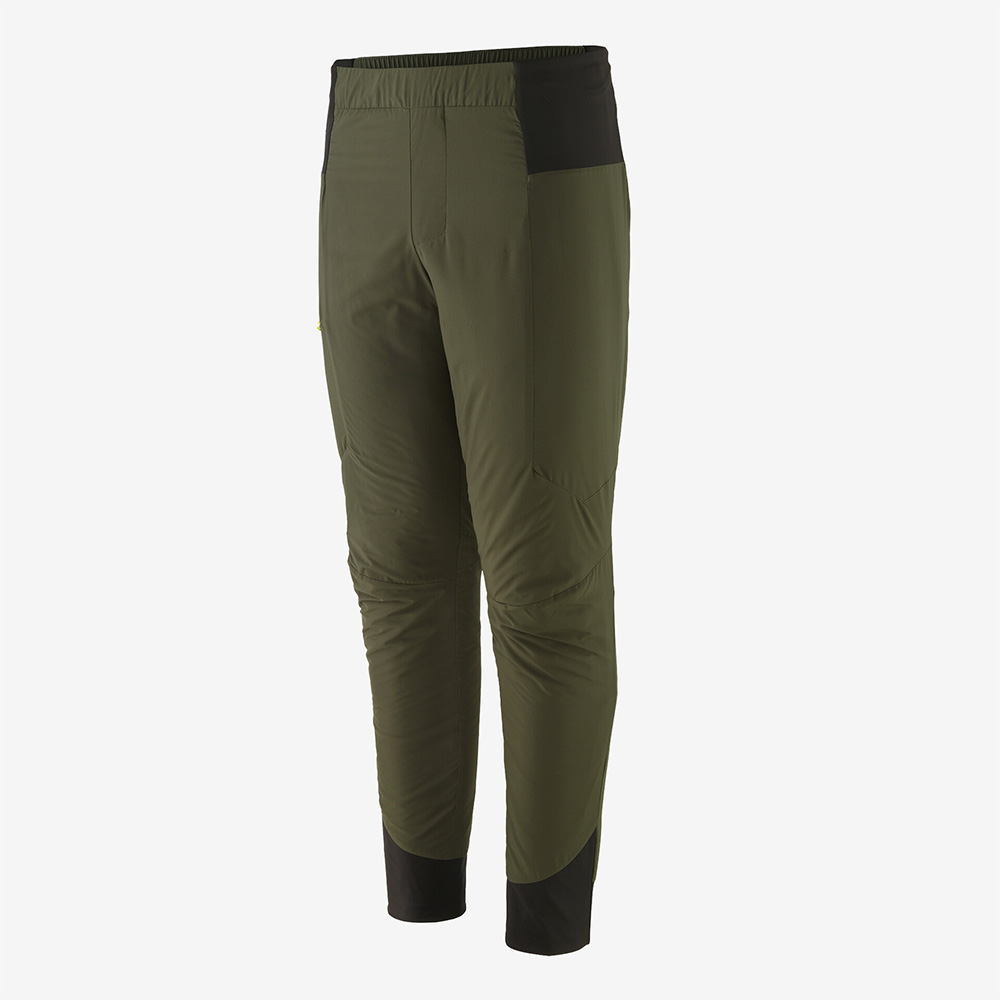
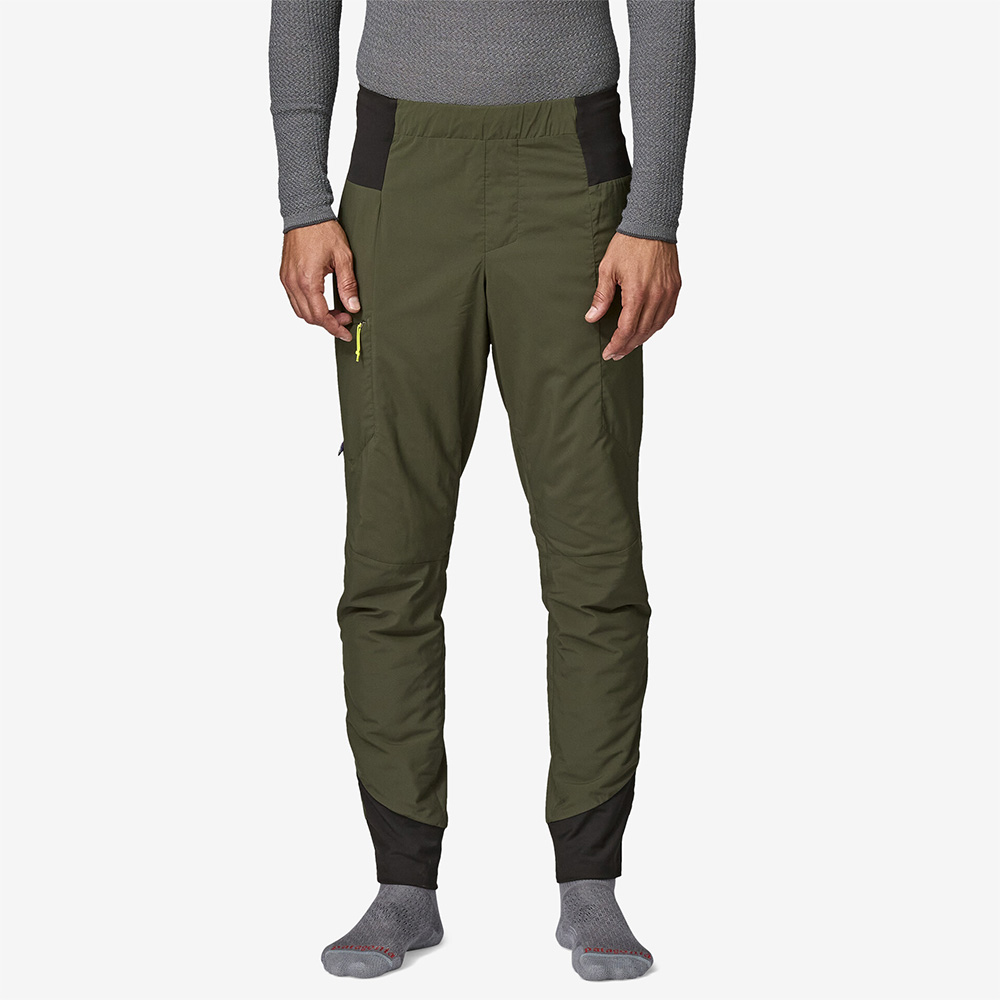
They pack down better than most fleece pants, yet they offer more warmth in most cases. They lose some insulative value in very high winds, but that’s just a compromise you have to make to achieve the impressive breathability they offer. (If you care more about warmth and weather protection than any sort of breathability, consider more traditional puffy pants like Patagonia’s DAS Light Pants.)
The main differences with these new bottoms are that they feature a notably more tailored cut with less extra volume from the knee down, as well as a revised waistband and pocket layout. The new fit makes them more practical in technical layering setups where you don’t want extra bulk created by your midlayers; I can run the Nano-Air Light Bottoms under my ski pants on ultra-cold days without noticing them much (I do have to bunch them up a bit above my ski boots).
I appreciate that Patagonia added a minimalist shoestring-style belt to this new version, which helps keep them up if you’ve got a heavy item in the pant’s pocket, though I wish they would’ve placed a zippered thigh pocket on both legs, not just the right one.
That aside, the Nano-Air Light Bottom is one of my all-time favorite pieces of apparel. It’s a perfectly cozy at-home pant if you keep your thermostat on the lower side like I do, but it’s also an excellent bottom midlayer for really cold resort skiing days, alpine climbing, or for fishing when layered under waders. And, like the original, it’s clutch for colder-weather camping, since it adds appreciable warmth without being quick to make you sweat. I don’t wear it as an outer layer if I’m going to be rubbing against a lot of pokey sticks or abrasive rocks, but its stretch-ripstop fabric has been surprisingly durable so far.
The Nano-Air Light Bottoms are obviously pricey if you’re just going to use them as a lounge pant, but for me, the comfort alone is worth it. Take into account the fact that my original Nano-Air Pant is still in great shape after hundreds (if not thousands) of days in it, and I’d consider it one of my best investments.
Patagonia W’s R1 Thermal Bottoms
MSRP: $149
Kristin Sinnott: I’ve had a pair of Patagonia’s R1 pants for over a decade. My husband and I both purchased them for what we thought would be a very cold ski trip, since we wanted a warm midlayer to wear under our ski pants. We don’t actually wear them too often as a midlayer, but we still wore them all the time on that ski trip, the past 10 years of ski trips, and for a lot of other occasions, including camping and lounging around the house. We loved them so much we purchased them as gifts for our family members over the years. We still wear them regularly when we need something warm and cozy to wear, and they have aged well; they look as good as new.
Patagonia recently came out with a new style of R1 pants, this one falling under the new “R1 Thermal” collection. In addition to their denser and slightly warmer fabric, they are more fitted than the previous unisex version. With more of a jogger fit, they work better as a midlayer (since they’re less bulky), but I’ve also been wearing them for lots of other scenarios, whether that’s my son’s soccer practice or around town. I love how comfortable they are, and I’ve even received compliments about their look, which is always a nice surprise when you show up at school pickup in what are essentially high-end sweats, but the other moms have been impressed by them (maybe that’s a sign that I live in a mountain town with like-minded moms).
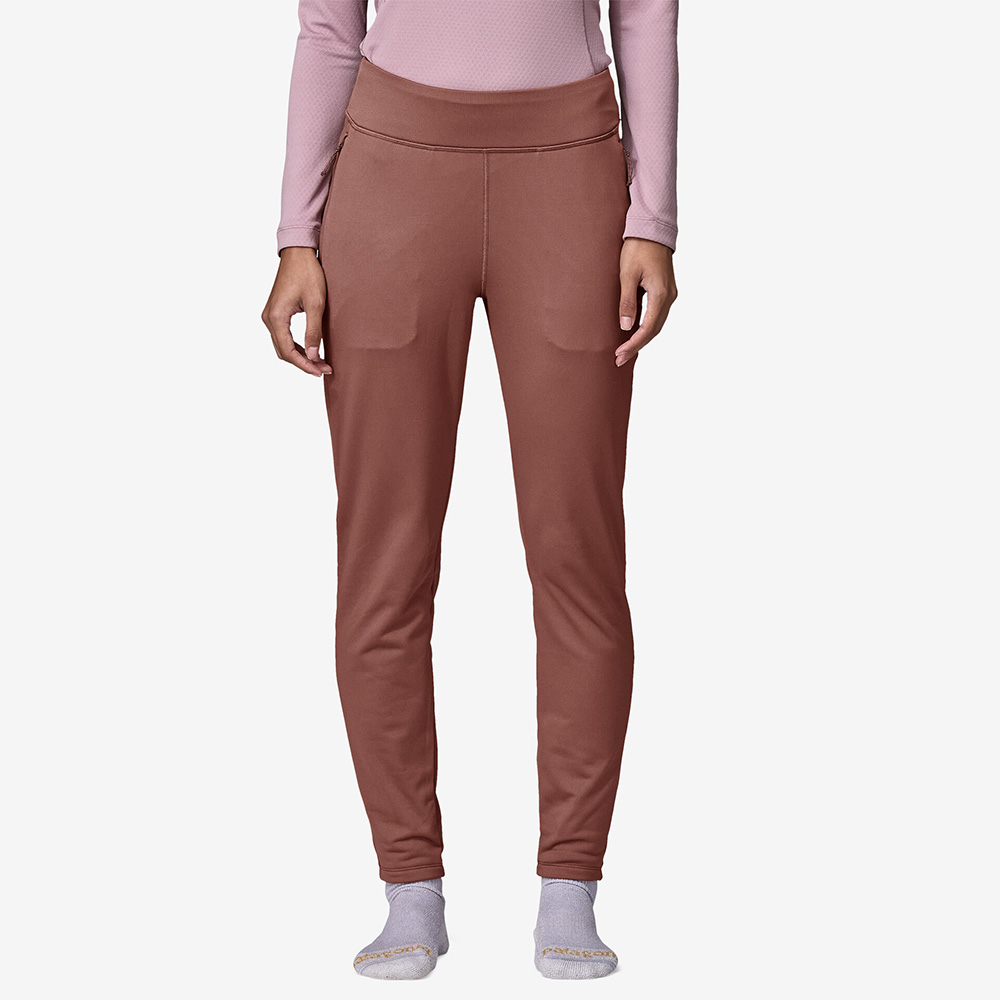
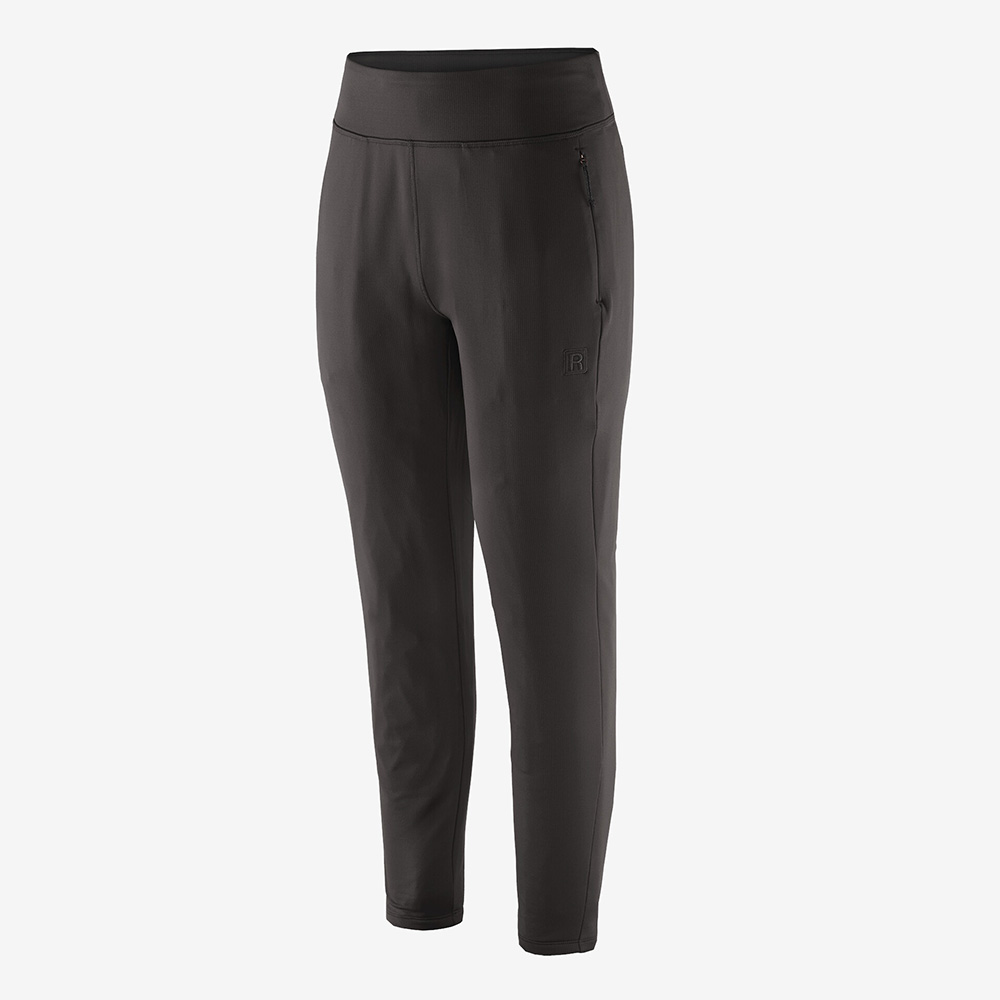
Norrona Falketind Gore-Tex Paclite Jacket
MSRP: $349
Luke Koppa: I’ve been testing a handful of ultralight rain jackets this summer and fall, and the Norrona Falketind Gore-Tex Paclite Jacket is one of the lightest, at 240 grams for my size Medium.
This jacket falls into the category of what I call “just in case” shells — they’re not what I pack if I know I’ll spend an entire day in heavy preciptiation, nor do I expect them to handle tons of abrasion (whether that means being worn under a heavy backpack’s straps or being scraped against sticks, rocks, ski edges, etc.).
Within that category, the Falketind Gore-Tex Paclite Jacket stands out for its weather protection and packability. This was my first long-term experience with Gore-Tex’s “Paclite Plus” laminate, and I’ve been impressed so far. The first-gen Paclite fabric wasn’t particularly durable or comfortable on skin, and the “Plus” version is a step up in both regards.
This is still a very thin “2.5-layer” fabric, consisting of a 20-denier recycled ripstop nylon face fabric, the waterproof Gore-Tex membrane, and a printed, slightly textured backer. If you’re looking for a shell that will need to deal with a lot of abrasion, I’d recommend a burlier 3-layer option, such as Norrona’s Trollveggen Gore-Tex Pro Light Jacket.
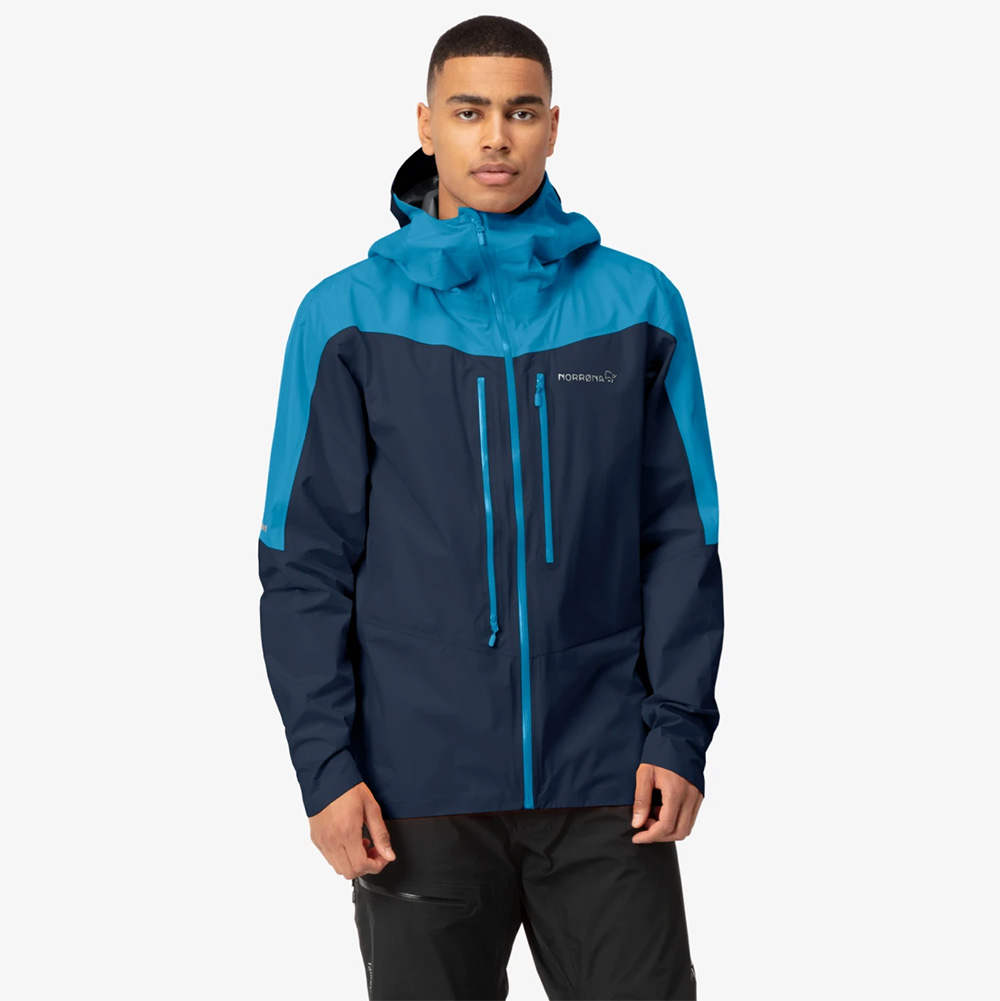
But, as a just-in-case rain shell, the Falketind Gore-Tex Paclite Jacket has done its job admirably. Its printed backer is less sticky on skin than most 2.5L shells, it has kept me dry during many 1-2-hour downpours this summer, and it packs down to the size of a grapefruit.
Despite its minimalist build, this shell still gets you an adjustable, helmet-compatible hood with a wire brim, Velcro cuffs, a generously sized chest pocket, and a vertical chest vent. The fit is on the slimmer side, but I can still easily fit a midweight puffy underneath. It’s also longer through the arms and hem than most similarly light shells, and it still offers good shoulder mobility (Norrona’s Falketind collection is designed for mountaineering).
My only noteworthy complaints with this jacket stem from its zippers. They’re really small and undoubtedly helped Norrona keep its weight and packed size small, but they’re quite difficult to use with one hand (I typically need to use the other hand to keep tension on the ultralight fabric to get the zippers to slide).
I can’t attest to the Falketind Gore-Tex Paclite Jacket’s lifetime durability, but so far, it’s showing zero signs of wear. It’s lived most of its life packed into the bottom of various packs, but I have frequently worn it under a biking hip pack (with a camera + 2 lenses inside), as well as my heavy hunting backpack setup. Either of those use cases can quickly wear off a 2.5L shell’s interior printed backer, but the Falketind Gore-Tex Paclite Jacket isn’t displaying any premature wear.
There are more affordable alternatives in the ultralight rain shell class (see the Strafe Scout, below), but the Falketind Gore-Tex Paclite Jacket’s above-average weather resistance makes it appealing if you want to prioritize that in your just-in-case shell. Or, if you want a bit more breathability, check out Norrona’s Senja Gore-Tex Active Jacket — it’s very similar overall but uses a 3L Gore-Tex Active laminate (I’ll write up that piece in a future post).
Uvex Sportstyle 236 Set Sunglasses
MSRP: $175
Kara Williard: I’ve spent a bunch of time this bike season in the Uvex Sportstyle 236 sunglasses. I’ve been converting to “shield” style sunglasses like it, but haven’t necessarily found the pair that best fits my face. That said, the Uvex Sportstyle 236 comes pretty close. It’s a smaller and lighter frame than my go-to Smith Wildcat sunglasses, and the Sportstyle 236 has proven more breathable / less prone to fogging on humid or wet rides.
The Uvex Sportstyle 236 frames are smaller than the Smith Wildcat, and because of this, I’ve found these Uvex sunglasses to integrate a bit better with my bike helmets. The Sportstyle 236 comes with two lenses, one of which is clear, which I personally love, especially for darker evening rides in the Fall. Once you know the system, the lens change process is quick, easy, and fairly intuitive. The adjustable nose piece also makes for a more comfortable and customizable fit.
After sustained use on many rides this summer, I’ve found the Slopestyle 236 sunglasses to be quite durable, especially considering how lightweight they are. Their field of vision offers pretty good periphery, while still letting some airflow in. Overall, these have been an excellent, well-rounded pair of athletic shades, especially if you are looking for more of a moderate, medium-sized frame, and an interchangeable option that isn’t absurdly pricy.
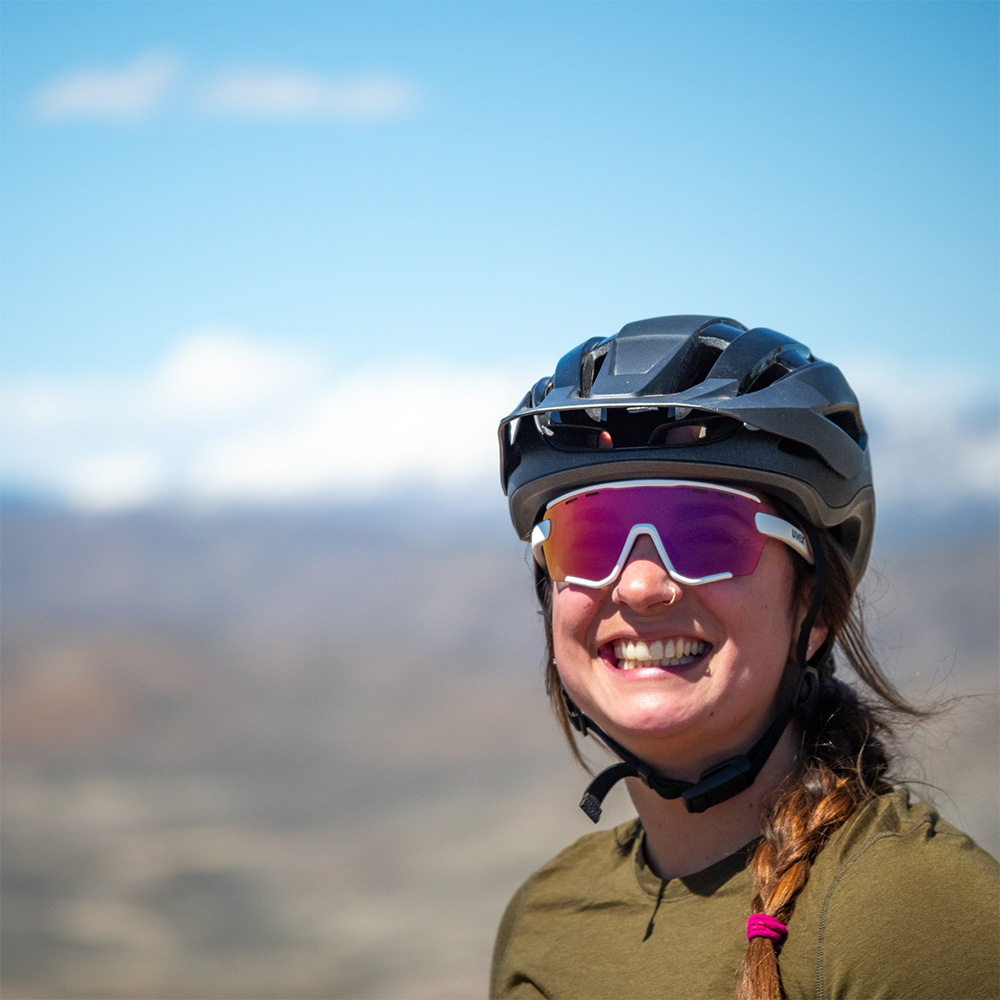
Strafe Pertex Shield Scout Jacket
MSRP: $249
Luke Koppa: Strafe claims that their Scout Jacket is “the lightest hooded rain shell on the market.” I haven’t scoured the entirety of the internet to verify that, but it is really dang light — my size Medium weighs just 108 grams. Fully smushed down, it’s barely the size of an average-size apple, my slightly above-average-size fist, or a below-average-size softball.
Like the Norrona Falketind Gore-Tex Paclite Jacket, the Strafe Scout Jacket falls into the class of my “just in case” rain shells. The Scout’s even lower weight and more-ultralight-er construction makes it more of a niche piece, but also a more appealing one for certain use cases.
Namely, the Scout’s ludicrous lack of mass and bulk makes it really easy to justify bringing along on just about any outing. I can stuff it into the pocket of most shorts, pants, and bike jerseys, meaning I never need to be left soaked and shivering during an always possible afternoon thunderstorm in the mountains.
The Scout’s 2.5-layer Pertex Shield laminate uses a gossamer 7-denier ripstop nylon face fabric, the Pertex Shield waterproof membrane, and a subtly textured printed backer. The resulting fabric is so thin it’s partially transparent and barely noticeable while wearing the jacket.
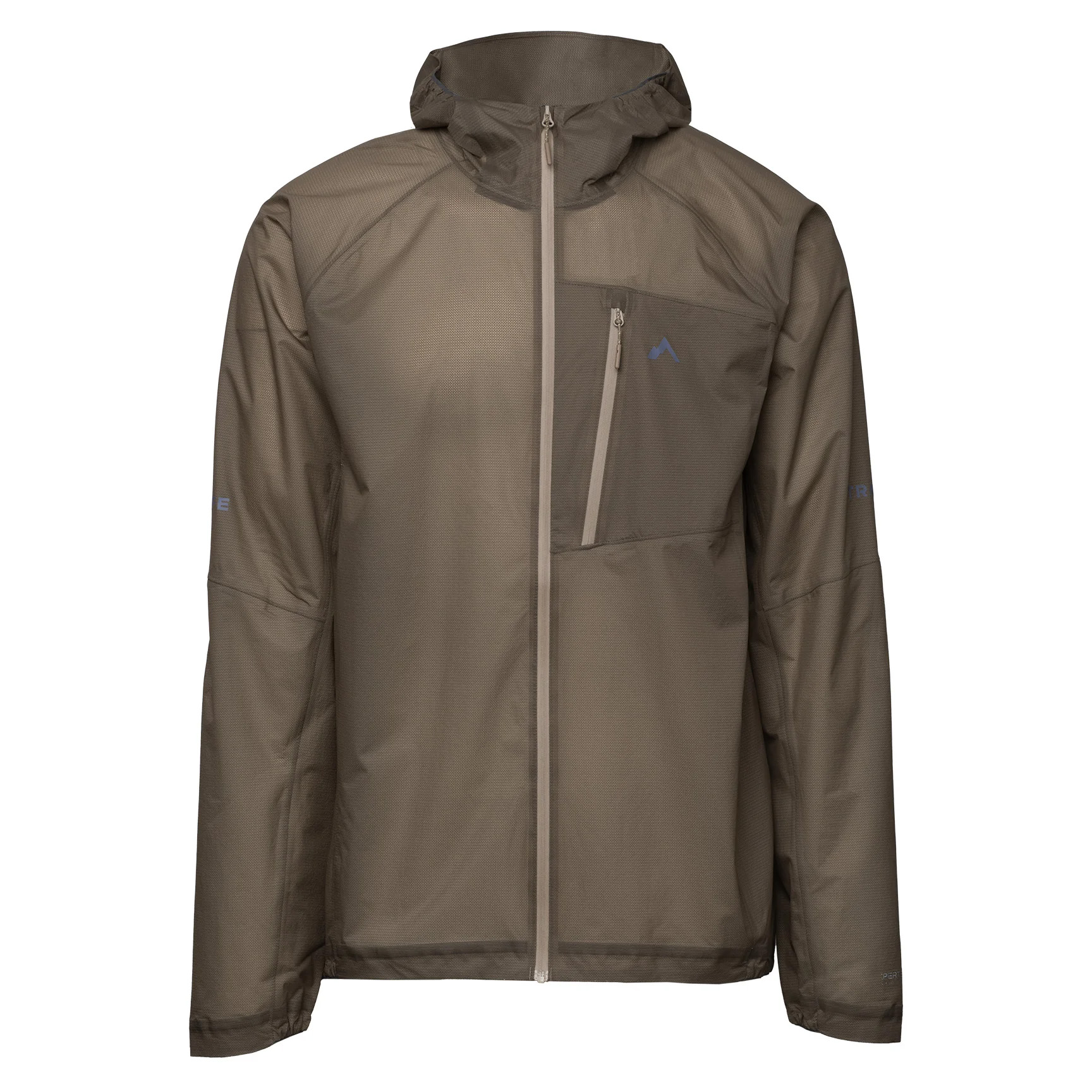
Strafe says this fabric is rated at 20K/20K for water resistance and moisture-vapor transfer, and those stats seem accurate in my experience. I have yet to have water fully penetrate the Scout’s Pertex Shield laminate, though its ultralight outer face fabric is quicker to wet out than most burlier 3L shells in extended heavy rain. That can make the Scout cling to my skin and feel like it’s letting water through, despite not actually being wet on the inside. Still, I wouldn’t reach for the Scout if I knew I was going to spend a whole day in the rain (especially if weight wasn’t a factor in that scenario).
In terms of breathability, the Scout is impressive for its class. I hate wearing any fully waterproof shell for extended periods of physical exertion, but when that’s on the menu and it’s raining hard, the Scout has been more comfortable than many 2.5L rain shells I’ve used. It’s likely aided by its small (6” / 15 cm) underarm vents, which you can’t seal closed but shouldn’t let any water in unless you’re reaching above your head a lot (e.g., climbing) while the rain is pouring down. I think the Scout is a tad more breathable than the Norrona Falketind Gore-Tex Paclite Jacket, whereas I trust that Norrona jacket a bit more in terms of long-term weather protection and durability.
By creating such a lightweight overall package, Strafe unsurprisingly had to forgo most features when designing the Scout. It has a full-zip closure, a zippered chest pocket (that doubles as a stuff sack), and non-adjustable (but elasticized) cuffs, hood, and hem — that’s it for bells and whistles.
Between that and the Scout’s extremely thin fabric, I try to avoid exposing it to lots of abrasion. So far, it’s held up well to a few days wearing it under a heavy pack, but I’ll try to keep that to a minimum since I don’t expect it to hold up well to that sort of friction.
However, if you want an extremely packable rain shell that still offers impressive levels of water resistance and breathability, the Scout Jacket is excellent. It makes a compelling case for never leaving it at home when there’s even the slightest chance of you needing some rain or wind protection.
Pearl Izumi Summit MTB Pants
MSRP: $145 USD
Zack Henderson: As the last in a long family line of sweaty Henderson men, I was admittedly skeptical of mountain bike pants for quite a while before I finally tried some — and boy am I a convert. Puddles and trail debris no longer go straight to my calves and down into my socks and shoes, and the added coverage does feel a touch more confidence inspiring, even if a thin layer of polyester is unlikely to really do much in a crash.
Despite their upsides, as the heat and humidity tick up in Northwest Washington through the summer, I have still been forced to tuck my precious riding pants in their drawer to await the Fall cooldown. But earlier this year, I took a chance on the very thin and well-ventilated Pearl Izumi Summit pants, and they’ve proven to be the closest thing to an all-season mountain bike pant that I’ve experienced.
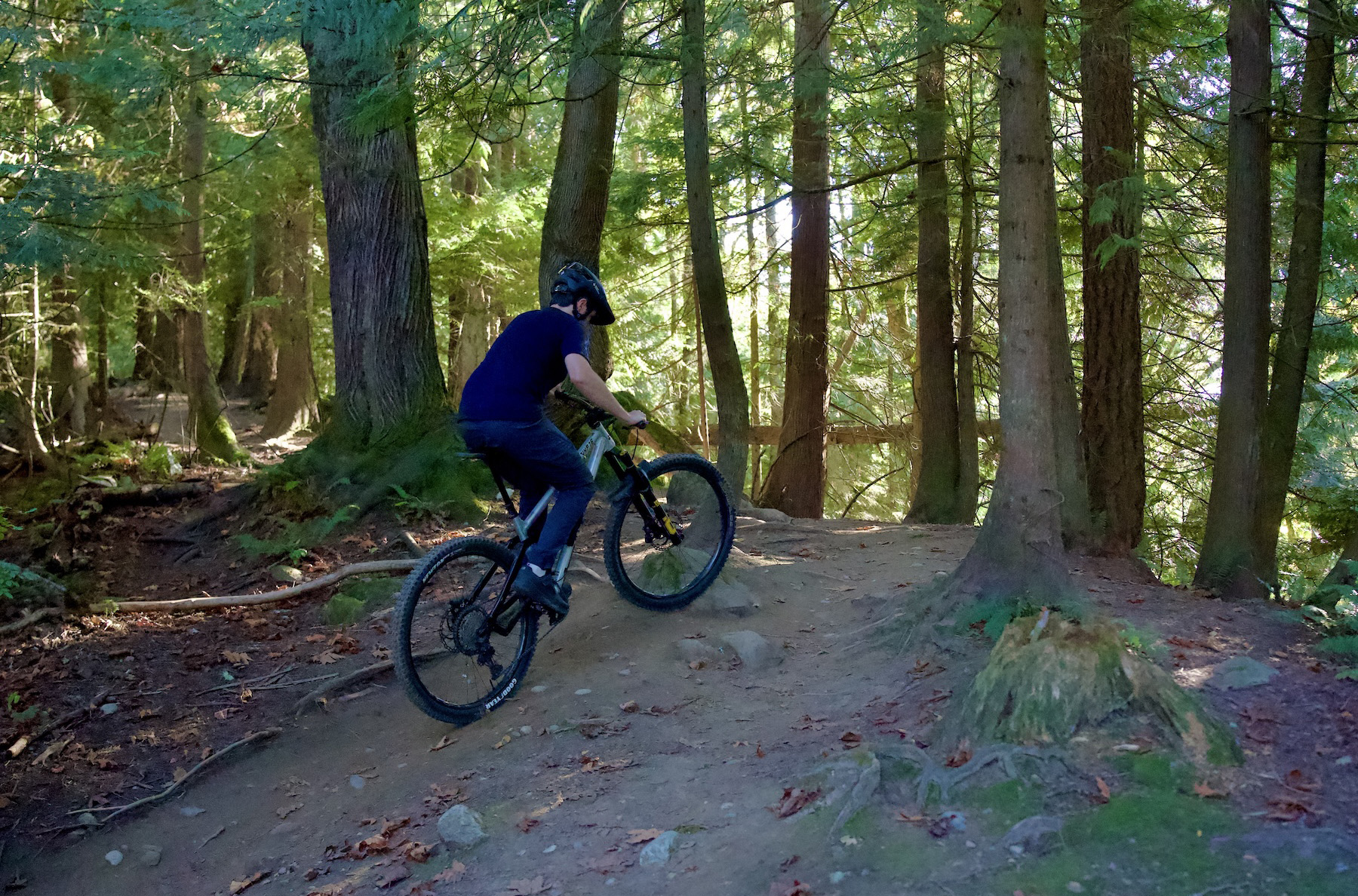
The Summit pants are cut from a very lightweight and stretchy polyester fabric (bonus points for recycled fabric contents) and use a metal hook on an adjustable nylon strap to fasten the waist.
I chose a size Medium for my 32-inch waist, and they fit absolutely perfectly — the 32.5’’ inseam is plenty long (short inseams drive me nuts, yet seem to be common), and the cut is slim enough to stay out of the way without being restrictive.
The inner thighs have laser-cut venting, and paired with the rather thin and soft fabric, the Summit pants can keep from getting clammy in higher temps than any other pants I’ve tried. I’ve taken the Summit pants on big rides in 80°F (27°C) temps, and while shorts still breathe better for obvious reasons, I wasn’t dying to get out of the Summit pants.
Features-wise, they’re rather minimalistic — there are no open hand pockets, but rather, a zippered pocket along the side of each thigh. These are my preferred pockets for actual trail use since they seem to do the best job of helping phones, keys, and whatever else stay out of the way and unnoticed. While the thin and stretchy fabric does lead to some bouncing while pedaling, it’s not too bad, and certainly more than tolerable for such a minimally structured pair of pants.
Pearl Izumi’s PI Dry technology applies a PFAS-free DWR coating to the individual fibers of the fabric, supposedly enhancing durability of the water-resistant coating. While they don’t seem to get waterlogged, the thin fabric can still get a bit flappy and clingy once it’s wet. The Summit pants also seem to wet out pretty quickly in even a drizzle, so they’re not my top pick for truly wet and cold riding — but there are myriad other pants options out there for that use.
While the downside of a very thin fabric is often durability, I’ve had a couple of smaller spills in the Summit pants and they’re no worse for wear. That said, they wouldn’t be my choice for more abusive bike park riding anyway since they don’t offer the same protection as a more substantial (and therefore much hotter) option. Instead, the Summit pants stand out for being the most warm-weather-friendly pants I’ve had the pleasure of using — and for that reason, they’re also the most worn pants in my ever-growing collection.
Kuhl Radikl Pant
MSRP: $109
Noah Eckhouse: I purchased my last pair of Kuhl pants probably 20 years ago, and they were a burly affair: thick cotton fabric, tough enough to withstand the rigors of camping, climbing or house building. But they also weren’t great at handling moisture (read: sweat), something I churn out consistently. So when I had a chance to try the updated, fully-modernized Radikl pant, I was interested to see how they had evolved.
Summary: they are amazing. They are a feature-loaded, fabric-evolved garment that addresses all my old complaints, look great, and are super comfortable.
I went for the Radikl Klassic cut in their Breen color. The first day I put them on, I went from business meeting to sweaty mountain hike to cocktail party. They felt great and looked great, dressing up or down throughout the day. They were never soggy, stayed crisp, and, while based on a traditional five-pocket design, the Radikl styling looks fresh and modern.
Technically, the pants are so full of details they basically have an owner’s manual silkscreened on the inside:

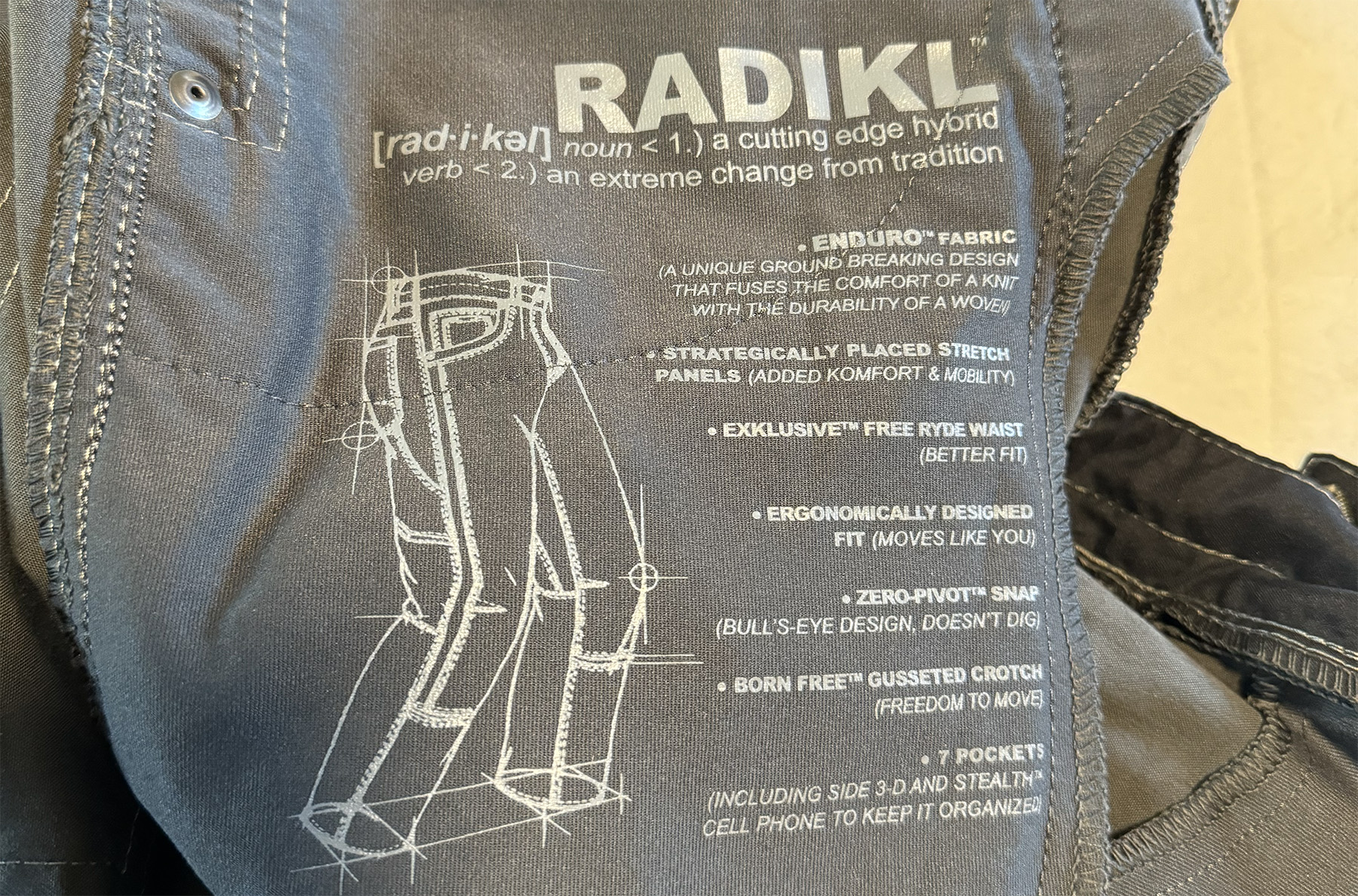
The Radikl’s primary fabric is a cotton / nylon / spandex blend, but the pants are full of flex panels that are a stretchy, breathable nylon / spandex combo. These panels, 1-2 inches wide, run down the inside and outside of the legs, under the knees, through the crotch, and across the back waistline. They make the pants incredibly comfortable and able to move with you. Other features include thigh pockets on both sides, articulated knees, SPF 50 fabric and a traditional watch pocket.
The pants have washed well and have a nice brushed-cotton look and feel. Available in 10 colors, they will be a staple in my wardrobe for years to come.
Pearl Izumi PRO Bib Short
MSRP: $225
Simon Stewart: Last week while we were filming up on the Monarch Crest Trail, I was talking with Dylan Wood about wearing bike shorts with a chamois, or going in the trendy minimalist direction by riding chamois-free. My take: I have been wearing shorts with a chamois for a really long time and have zero issues, so I have no interest in interrupting the status quo down below. I can’t afford to take the chance of going chamois-free, and potentially getting a saddle sore that prevents me from riding — so back to my take; if it’s not broken, don’t fix it.
That was a long-winded way of saying I always ride in bike shorts with a chamois, and the majority of the time they’re bib shorts. With that said, I’ve been spending time in the Pearl Izumi PRO Bib Short, and I now have plenty of miles in them to talk about how they perform.
The PRO Bib Shorts use Pearl Izumi’s PRO Levitate chamois, which is their “highest-performance” chamois. Pearl Izumi claims it offers more support than anything else on the market by incorporating their PRO Next-Gen Suspension Core® technology, which utilizes ultra-high-density and medium-density layers to distribute body weight. The PRO Levaitate chamois is also said to have excellent stretch and breathability.

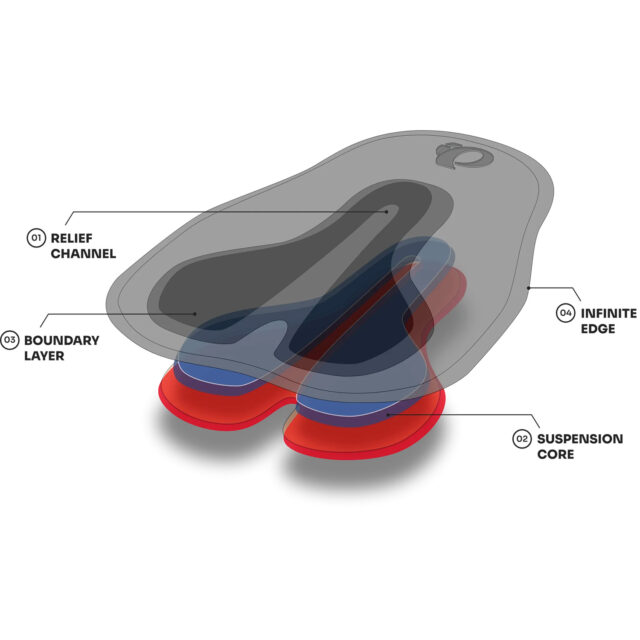
Moving out to the rest of the shorts, the PRO Bibs features 7-panel construction (claimed to minimize seams) with the “luxurious feel” of Italian PRO Transfer fabric. Laser-cut raw edge hems and straps tie it all together, plus Pearl Izumi includes BioViz® reflective detailing for added nightime visability.
The first thing I noticed when I put on the PRO bib shorts was how soft and comfortable the fabric felt, and there was nothing in the way they fit that didn’t feel amazing. I usually don’t go for a long first ride in an unproven chamois, but how good they initially felt gave me confidence, so I did.
After a four-hour mountain bike ride, I have to say that the Pearl Izumi PRO Bib Short is one of the finest bib shorts I have every worn — and I’ve had plenty of fancy european bibs over the years. Pearl Izumi got the most important part right because the triple-density PRO Levitate chamois is superb — it’s not bulky, yet still incredible supportive, comfortable, and breathable.
When wearing the PRO Bibs under mountain bike shorts, I find the 10.5” inseam to be just right for covering the top of my knee pads, and the stretch in the fabric clings to the knee pad material nicely. Bib straps can often be a point of discomfort, but the PRO Bib Short straps have a nice width and feature the same lovely fabric that makes up the rest of the shorts. As a result, they feel great, and I never have to think about them again after putting them on.
I have my preferred bib shorts for big days in the saddle, which I call my long-range chamois, and there’s usually only a select few that get that distinction. The PRO Bib Shorts have shot up to the top of my long-range list; they’re the ones I’m always looking for, and if I find them dirty in the clothes hamper I’m pretty bummed.
Wild Rye Danner High Pile Fleece Jogger
MSRP: $119
Size Tested: Large
Kara Williard: I’ve been searching for an extra cozy pair of pants for the colder temperatures on the horizon, and those have materialized in the form of Wild Rye’s all-new High Pile Fleece Jogger. This is a classic high-pile fleece pant – they’re quite thick and bulky but also super soft, cozy, and warm. So far, I’ve found them ideal for lounging, whether it be cold mornings, working in a chilly house, cold nights of camping or being outside, or just anytime I want to be comfortable and warm.
They have a great fit – plenty roomy and comfortable, but still somewhat flattering. I really like the drawstrings at the ankles, and the length of the size Large is long enough on my 5’9” frame to hit at about my ankle bones. I can also cinch them up with the drawstring to be more of a jogger style. The waist is a smidge tighter and less flexible in its material than I originally expected, but it does relax a bit and can be adjusted via a drawstring.
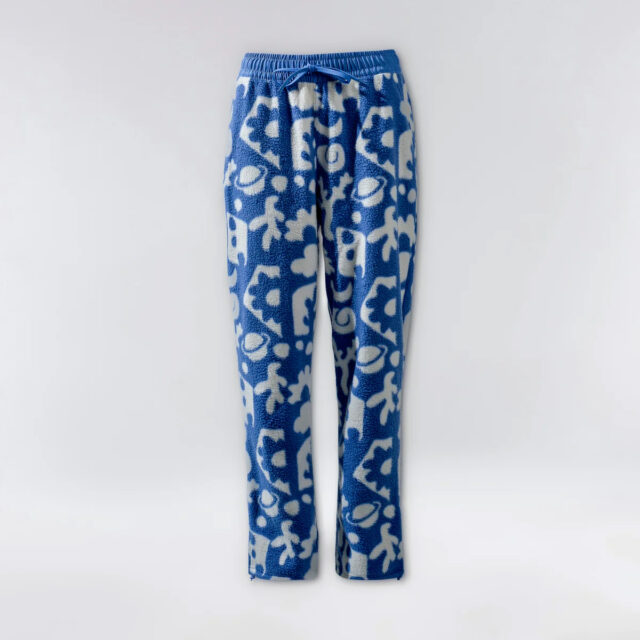
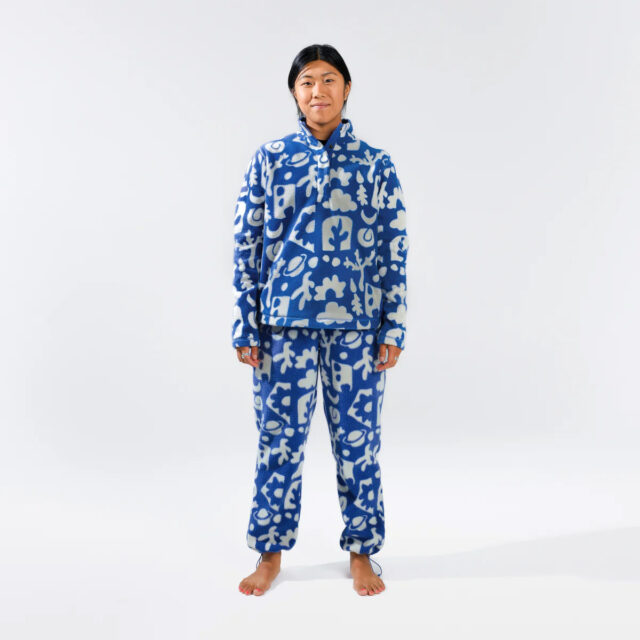
For the upcoming super cold temperatures of a Gunnison winter, the Danner High-Pile Fleece Joggers offer enough space to wear a baselayer beneath, and I have a feeling these fleece joggers will only be making more appearances as winter draws closer. Wild Rye also built a Danner High-Pile Fleece Pullover if you want to double up on cozy warmth and turn it into a whole outfit.
CEP Compression Socks
MSRP: starting at $14.95
Kristin Sinnott: I’ve been spending a lot of time this spring and summer in CEP’s compression socks. Their snug but not too tight fit and lightweight composition has been a nice change from some of the padded wool socks that I tend to wear for running and hiking. While the thicker wool socks are great for certain scenarios, sometimes I want something a bit thinner and more form fitting.
The Ultralight Low Cut socks have been great for the gym, running, and hiking, whereas I’ve been gravitating toward the Hiking Light Merino Mid Cut Compression Socks for bike rides. I wear both in size Medium and it’s a good fit on my US Women’s size 8 feet.

Orvis PRO BOA Wading Boot
MSRP: $298
Jed Doane: Fishing boots have always been a necessary evil for me. They’re clunky and seem to disintegrate when it matters most. I’ve also always had trouble with keeping boots tight-but-not-too-tight since, when the laces take on water, they always seem to loosen and are difficult to keep uniformly snug. As BOA technology has improved and become more reliable in snowsports, I’ve been curious to see how it would translate to the fishing boot, given the intrinsic problems with standard lacing.
Orvis’ PRO BOA Wading Boot is expensive, but it is built with top-shelf materials and performs accordingly. I love the outsole, which was developed with Michelin for better traction in the water — it was noticeably more dependable than previous boots I’ve worn. I also appreciate that the sole is stiff torsionally underfoot while still being comfortable over long approaches. This torsional stiffness is much appreciated when wading over slick, uneven rock.
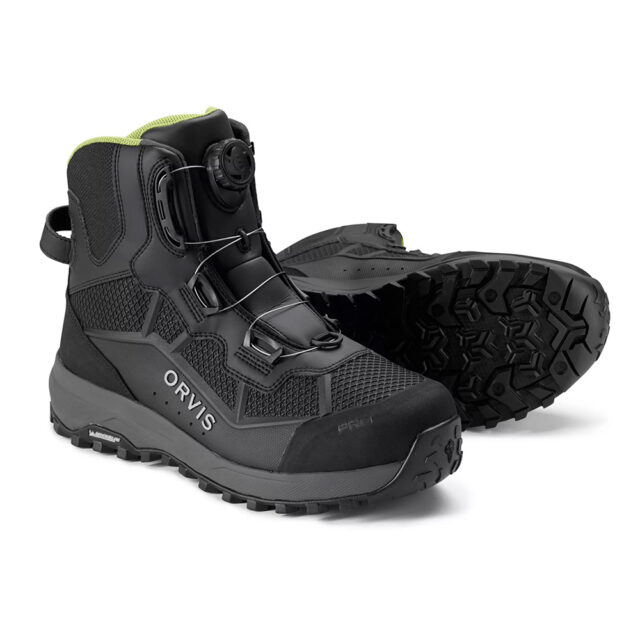
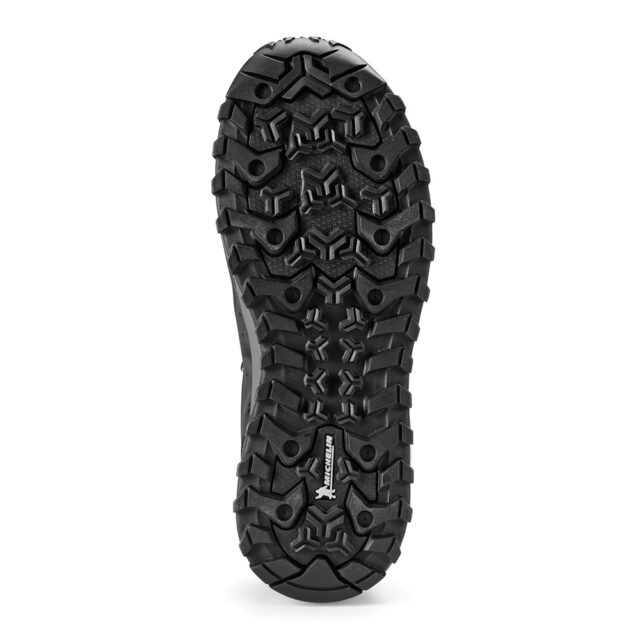
Orvis also designed a seamless PU upper specifically for this boot, which is actually pretty significant. I’ve found seams in wading boots, especially near the toe cap, to be common sites for failure, given the water stress on the thread and the abuse of kicking rocks while wading. Limiting the failure points on the upper should make for a noticeable improvement in durability; I look forward to putting more seasons in these boots to fully test that hypothesis. I also found that the PRO BOA boots are noticeably lighter, especially when wet, and have lower drying times when compared to other boots I’ve used.
Lastly, the BOA closure system has turned out to be a godsend relative to traditional lacing systems. I’ve long struggled with overtightening my laces at the car, suffering through the approach, and then having the boots get soggy and loose throughout the day. The BOA system is easy to adjust, even when wet, and doesn’t require much tinkering throughout the day.
Montane Women’s Fireball Lite Hooded Insulated Jacket
MSRP: $250
Size Tested: Large
Kara Williard: I love a breathable but insulated midlayer, and the Montane Fireball Lite strikes me as one of the best options I have tried in this category. I’ve spent quite a bit of time in it these last few weeks as temperatures have been dropping, and I have been impressed by its warmth, as well as its active breathability.
When I am moving and sweating, the Fireball Lite has been one of the better midlayers I’ve used in terms of breathability, while still offering valuable insulation in cooler temperatures. And, when layered with a more windproof and/or waterproof piece on top, it provides quite a bit of warmth, thanks to its combo of 40-g recycled Dynamic Eco insulation and more breathable fleece grid fabric along the sides and underarms.
The Fireball Lite is also really soft and stretchy, and provides good articulation for active use (i.e., it’s not restrictive at all, even with awkward movements). The size Large is pretty generous when it comes to the length of the sleeve and torso, which works well for me; it’s otherwise somewhat slim through the torso.

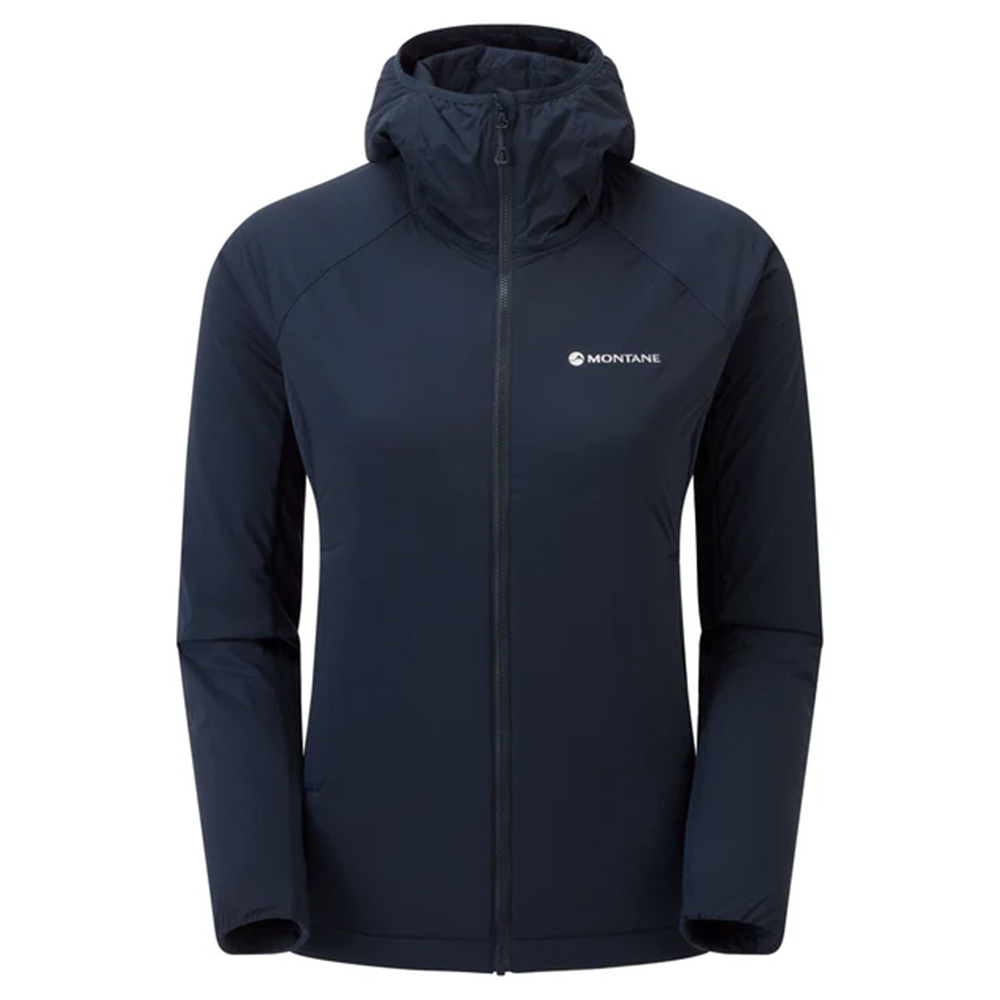
As far as insulated midlayers go, the Fireball Lite is one of the more packable options I have, and also one of the most breathable and comfortable, making it an easy choice for an assortment of outdoor activities in cooler temperatures.
Patagonia R1 Thermal Full-Zip Hoody
MSRP: $219
Luke Koppa: Patagonia makes a ton of different fleece layers — to put it into perspective, they now offer six different variants of their “R1” series alone.
We’ve covered several of them in the past, from the lofty R1 Air to the protective R1 TechFace. And the original (though continually tweaked) R1 remains a great choice for those seeking a slim-fit, highly breathable fleece.
The “R1 Thermal” line is the newest addition to the family, and I’ve spent a lot of time in the R1 Thermal Full-Zip Hoody, starting last winter. As the name suggests, it’s a warmer alternative to the standard R1.
The R1 Thermal fabric has a low-profile micro-grid knit on the interior and a tighter-knit face. It doesn’t resist moisture or wind as well as the softshell-like R1 TechFace, but the R1 Thermal offers more weather protection than the standard R1 and (especially) R1 Air, while being comparable to the R1 Air in terms of overall insulative value.
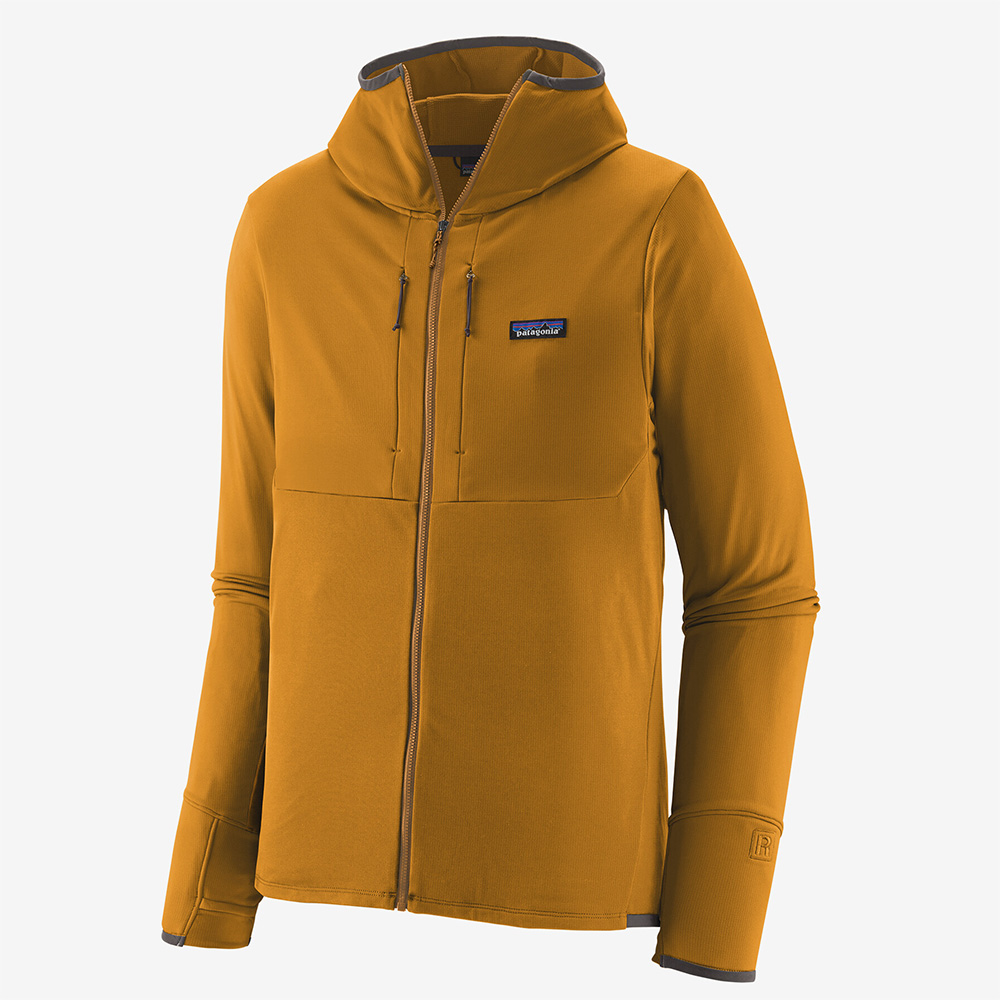

The R1 Thermal Hoody’s fit is pretty slim — I won’t wear more than a baselayer underneath it — but its stretchy fabric and articulated fit keep it from feeling restrictive. I appreciate its long arms and thumbholes when my hands are cold but I don’t want to throw on gloves, and I love that it comes with dual zippered chest pockets — great for a phone, wallet, etc. Its small hood is designed to be worn under a helmet, but it can stretch over a cap or beanie.
As I’ve found with many similarly slim fleece layers, I find the R1 Thermal Hoody’s throat / neck area to be a bit snug when fully zipped up with the hood down, but it does function pretty well as a sort of balaclava with the hood up. For reference, Patagonia also offers the R1 Thermal in a non-hooded jacket, a crewneck pullover, and a pant.
So, where does the R1 Thermal really excel? It was one of my go-to midlayers of winter resort skiing last year, but I find it most useful when I need a fairly warm midlayer that is quite breathable but still offers some degree of weather protection when worn as an outer layer.
Let’s put that into perspective by comparing it to the rest of the R1 family tree. The R1 TechFace is better the more you’ll be using it as your outer layer in somewhat inclement weather, but it doesn’t offer quite as much insulation and is bulkier when layered under other shells. The R1 Air is more breathable and likely a touch warmer under a shell, but it offers barely any wind or water resistance. The standard R1 is more breathable and packable, but not quite as warm or weather-resistant.
In my case, the R1 Thermal Hoody has filled a few niches for me. It’s a great midlayer for resort skiing when the temperatures are a bit too warm for the Patagonia Nano-Air Jacket (my go-to midlayer for mid-winter resort skiing). I’ve also been using it as an outer layer for chilly early-morning hikes, bike rides, and spring ski tours — all are situations where I prioritize breathability but want some wind resistance. Within the R1 family, the Thermal is probably the most versatile option if you want a fairly warm midlayer that still functions well as an outer layer in drier conditions.
Norrøna Femund Equaliser Shirt
MRSP: $89
Jed Doane: We’ve often sung the praises of merino / synthetic blends for baselayers, and this lightweight offering from Norrøna is a great do-everything outdoor shirt that I’ve used all summer in a variety of conditions. It has a slightly higher merino content (47%) than some other hybrid shirts I’ve used, but I’ve been really impressed with its wicking and stink-resistance, as well as durability.
I used it as my only active shirt for several multi-day backpack trips, and found that the wool has held up with minimal pilling underneath pack straps. For Norrøna, which tends to run slim, this shirt has a slightly baggier fit, but still ran true to size. it also has a microfiber sunglass wipe built into the hem, which I haven’t used much but could be helpful for mountain bikers. Those interested in a durable summer multi-use shirt should take a look.
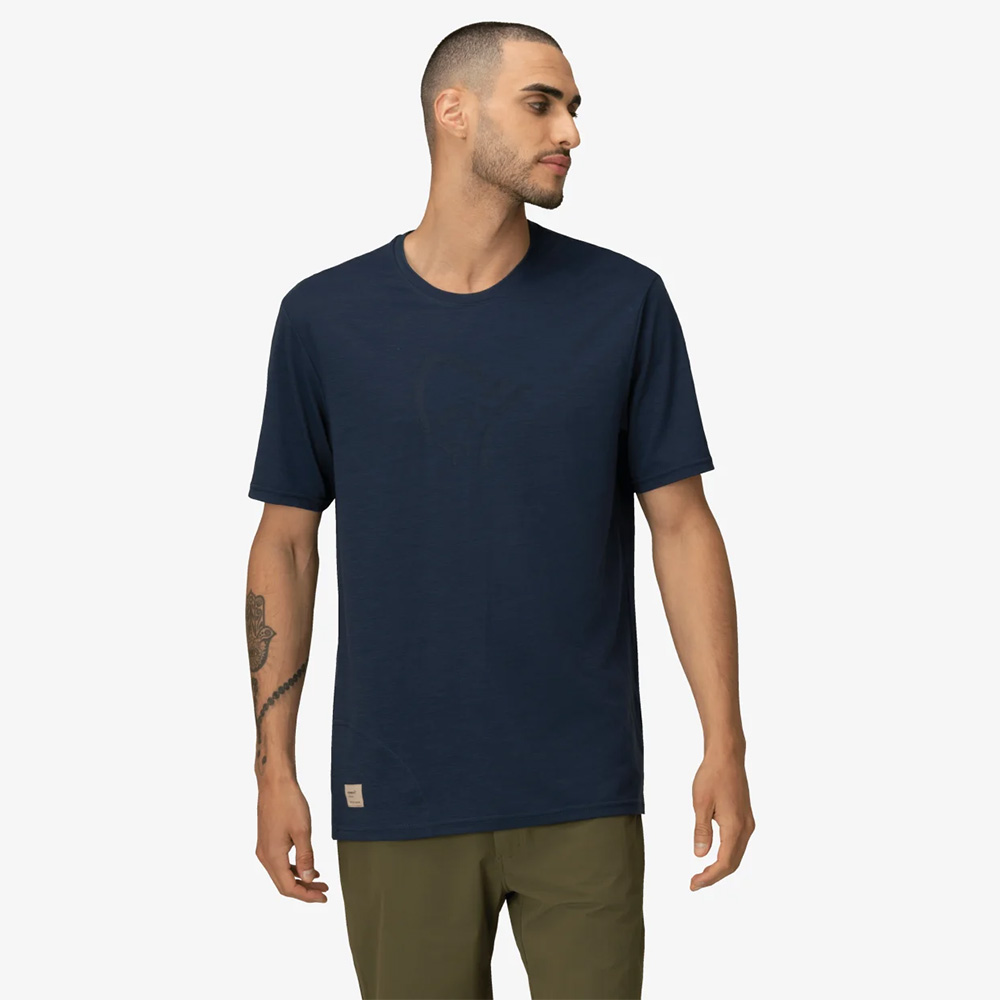

I always ride with a chamois under my MTB shorts. Best product I’ve used so far is Velocio’s Mesh Bib Liner. The pad and leg grippers are really high quality. There are storage pockets on either side. And the mesh is super breathable (I mean you can see right through it). The only downside is that if you crash hard on rocks or hardpack, they can easily tear. I probably crashed a dozen times with no issue but then tore a hole eventually. https://velocio.cc/collections/off-road-equipment/products/mens-trail-mesh-bib-liner?variant=40321423573065